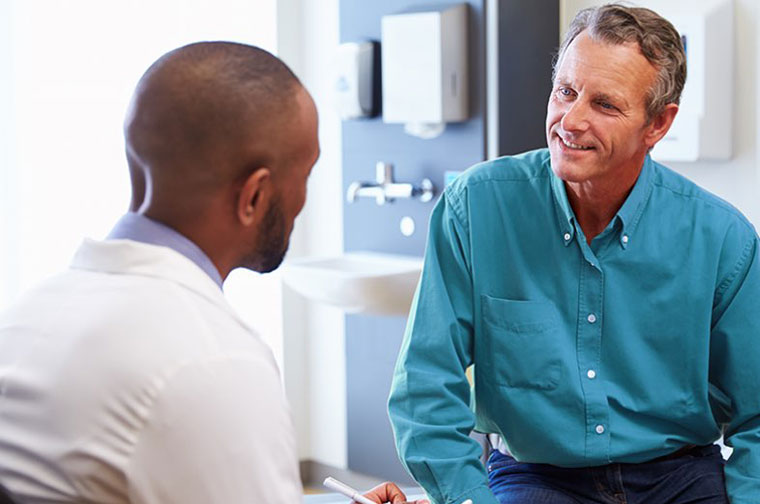KIDNEY STONES
At Minnesota Urology we focus on diagnosis, treatment and prevention of painful kidney stones.

Kidney Stone Diagnosis, Treatment and Prevention
Kidney stones can cause unpredictable pain and can impact your ability to move and function. Our team of urologists is dedicated to providing the right diagnosis and the best treatment plan, and we work with you to reduce the chances of future stones.
Find A Physician
About Kidney Stones
Most people don’t feel a growing stone. In fact, many feel well until the kidney stone tries to pass. Most kidney stones form slowly, over months to years, so most patients have had their stones for a long time before they cause them any trouble.
-
What is a kidney stone?
A kidney stone is a large crystal formed from the minerals in your urine that resembles a small pebble or rock. Some stones can be quite dense and hard, while others are softer and more friable. The density of the stone is determined by its composition, as well as how long it took to form. Most kidney stones contain calcium combined with either oxalate or phosphate to form crystals. Approximately 85% of kidney stones contain calcium. Most of the rest are uric acid stones, formed from another mineral in the urine. Only a few are other kinds of minerals. We determine what kind of kidney stone you have by identifying the stone crystals in a laboratory in a process called crystallography. If you pass a kidney stone, bring the stone in to help us determine what your next steps should be.
-
What are the symptoms of kidney stones?
Sometimes stones do not cause any symptoms. Stones in the kidney that don’t block the flow of urine usually don’t cause pain.
When a stone leaves the kidney and travels to the bladder through a narrow tube called the ureter, it can become stuck. The stone then blocks the flow of urine out of the kidney, causing the kidney to stretch. This stretching of the kidney and ureter is what causes pain.
Symptoms of a kidney stone may include:
- Sharp, cramping pain in the back, side, or abdomen. The pain may travel to the lower abdomen or groin. Many patients say this is the worst pain they have ever experienced. The pain often begins suddenly and comes in waves. It can come and go as the body tries to get rid of the stone.
- A feeling of intense need to urinate
- Urinating more often or feeling a burning sensation during urination
- Blood in the urine
- Nausea and vomiting
- For men, pain in the tip of the penis
- Fever or chills
-
What are the treatment options for kidney stones?
Treatment depends on the type of stone and the situation.
Sometimes we wait for the stone to pass.
Many stones that get stuck in the narrow parts of the ureter pass on their own into the bladder. Smaller stones are more likely to pass on their own. Once stones make it down into the bladder, the pain often resolves because the ureter and kidney are no longer obstructed. Stones usually make it out of the bladder without any trouble, and you may not feel the stones passing as they come out of the urethra. Waiting 4-6 weeks for the stone to pass is usually considered safe, as long as the pain is bearable, there are no signs of infection, the kidney is not completely blocked, and the stone is small enough that it is likely to pass. While waiting for the stone to pass, you should drink plenty of water. It is important to stay well hydrated, but drinking excessive amounts of fluid will probably not increase the chance of the stone passing.
Common medications for kidney stones include the following:
- Tamsulosin – Certain medications can improve the chance that a stone will pass. The most common medication prescribed for this reason is Tamsulosin (Flomax). The dose is one 0.4 mg tablet daily. Taking more than this will not increase the chance of stone passage.
- Pain medications – There are two different types of medications that can be used for kidney stone pain: narcotics and NSAIDS (like ibuprofen). Many studies have shown that these are equally effective in reducing pain.
- Narcotics – The most commonly prescribed are Percocet (oxycodone 5 mg + acetaminophen 325 mg) and Norco (hydrocodone 5 mg + acetaminophen 325 mg). Two tablets can be taken every 4-6 hours, with a maximum daily dose of acetaminophen at 3,000 mg.
- NSAIDS – The most commonly used NSAID is ibuprofen. This may be very effective and can be purchased over the counter. The maximum dose of ibuprofen is 3,200mg per day. It is safe to alternate narcotics and ibuprofen. A blood test before taking ibuprofen regularly will ensure that your kidney function is okay.
- Medications for nausea – It is very common for kidney stones to cause nausea. Nausea can also be a side effect of narcotic pain medications. Commonly used over-the-counter nausea medications are meclizine (Bonine or Dramamine Less Drowsy) or dimenhydrinate (Dramamine). Ondansetron (Zofran) also is a very effective anti-nausea medication that requires a prescription.
-
When is surgery recommended?
There are certain instances when surgery may be needed. Surgery may involve placing a temporary stent or drain, or immediately removing a stone from the urinary tract. Surgery is indicated when:
- Even with time, the stone never passes.
- The pain is too great to wait for the stone to pass.
- The stone is affecting kidney function (based on blood work).
- There is too much nausea to be able to stay hydrated.
- The urine is infected.
-
What kinds of surgeries are used to remove stones in the kidney or ureter?
Today surgery usually involves either no or very small incisions (less than one inch), relatively little pain, and minimal time off of work.
- Ureteroscopy (URS)
Uretroscopy is most commonly used to treat stones in the ureter. It also can be used to treat stones in the kidney. URS involves passing a very small scope, called a ureteroscope, into the bladder, up the ureter and into the kidney. The ureteroscope enables the urologist to treat the stone without making any incisions. This procedure is done under general anesthesia so that you do not feel anything. Once the urologist sees the stone, a small basket grabs smaller stones and removes them. If a stone is too large to remove in one piece, it can be broken into smaller pieces with a laser. Once the stone has been removed, the doctor will place a temporary stent in the ureter because even after the stone is removed, swelling in the ureter can prevent the kidney from draining. A stent is a small, plastic drainage tube placed completely within the body and does not require an external bag to collect urine. You probably will go home the same day as the URS and can begin normal activity within a day or two. The stent will be removed 3-10 days later in the office and does not require anesthesia. It is very important that the stent is removed, as it can cause complications if left in place for an extended period of time (months).
- Shock Wave Lithotripsy (SWL)
Shock wave lithotripsy is most commonly used for stones in the kidney, but can also be used for stones in the ureter. Shock waves are focused on the stone, causing them to break into small pieces that pass out in the urine. This is the least invasive of all kidney stone procedures, as no instruments enter the body. Because of discomfort caused by the shock waves and the need to control breathing and movement during the procedure, anesthesia is needed. SWL only works well on certain types of stones and in certain locations. Usually no stent is required, which is one of the main advantages of SWL. With SWL, you probably will go home the same day as the procedure and can resume normal activity in two to three days. You may be given a strainer to collect the stone pieces as they pass, so they can be sent to the laboratory to be analyzed. Although SWL is widely used and considered very safe, it can still cause complications. You may have blood in your urine for a few days after treatment. Although most stone pieces pass painlessly, larger pieces could get stuck in the ureter, blocking urine flow and causing pain.
- Percutaneous Nephrolithotomy (PNL)
PNL is the best treatment for large stones in the kidney, as these can rarely be effectively treated with shock waves or ureteroscopy. General anesthesia is required, as PNL involves making a half-inch incision in your side and placing a tube from your back directly into the hollow center part of the kidney where the stone is. Through this tube, we can insert various scopes and stone-breaking instruments. The ability to suction pieces makes PNL the best treatment for large stones. After the procedure, we leave either an external drainage tube or a stent in the kidney to allow drainage of urine and to stop any bleeding. You probably will stay in the hospital overnight for this operation. Your urologist may choose to do Xrays while you are still in the hospital to see if any stone pieces remain. If they do, your urologist may want to look into the kidney with a telescope again to remove them. You can begin normal activity after about 1-2 weeks.
-
Kidney stone FAQs:
Why do kidney stones hurt so much? Why do they start hurting so fast?
Your kidneys are big filters that filter minerals from the bloodstream. Urine is produced and drains into a common, funnel-shaped area of the kidney, the renal pelvis that tapers down to the ureter. The ureter is a long, thin, muscular tube that transports the urine down to the bladder by “milking” the urine down the tube. Getting the urine from the kidney to the bladder is an active process, the only place urine is supposed to stay for a while is in the bladder. The ureter is a narrow tube and continues to narrow as it gets toward the bladder. A kidney stone that tries to pass down the ureter will only get so far before it will get stuck. Only small stones pass without getting stuck. If a stone gets stuck in the ureter and blocks the flow of urine, pressure will build as the ureter and renal pelvis continue to try to transport the urine to the bladder. As pressure builds, the ureter and renal pelvis are forced to stretch. The stretching causes pain. The pain of a kidney stone is often intense, and most patients are diagnosed when they come to the Emergency Department. Localized, acute, and severe back pain, nausea, and vomiting are typical symptoms. Fever and infection are not common and require urgent treatment.
I am having pain. How do I know if I have a kidney stone?
Kidney stones are best diagnosed with CT scans. Sometimes plain X-rays can clearly show a stone, but a CT scan of the abdomen and pelvis is nearly 100% accurate to diagnose the stone, determine its size, locate where it got stuck, and see how dilated the ureter and renal pelvis might be (hydronephrosis). Most all Emergency Departments use CT technology because it also can diagnose other possible reasons for your symptoms, such as appendicitis.
A CT Scan is a lot of Xray. Can’t I just have a plain Xray or ultrasound?
A plain X-ray is helpful in some cases and is most commonly used if you are having treatment by using shock waves. Many calcium stones can be identified on plain X-ray, but uric acid stones cannot.
Are there other tests I need?
A urinalysis is important. Traces of blood are often found. Signs of infection may require more urgent surgical treatment. Sometimes blood will help determine if you need more urgent treatment.
Why am I straining my urine? Won’t I know if the stone has passed when the pain is gone?
When you have been diagnosed with a kidney stone, you should begin straining all of your urine to know whether or not you have passed your stone. Some stones will be stuck in the ureter but won’t cause pain because the urine is draining around the stone. Some patients will think they have passed their stone because the pain goes away, only to be surprised later by another onset of pain. When you strain your urine, you will know when your stone has passed, and you can also bring that stone to our office so we can have it analyzed for the type of stone you’ve made.
I have had a stone before. What’s the best way to determine if I have a stone now that I should be worried about?
The easiest way to know if you have another stone is by getting a CT scan. Your specialist will help you decide if a CT scan is appropriate. CT scans are expensive and involve radiation, so we try to be judicious about ordering them only when we feel it is appropriate and necessary.
-
Kidney stone prevention:
At Minnesota Urology our goal is to minimize your risk of forming another kidney stone.
What Makes a Kidney Stone?
A kidney stone is formed from the minerals in your urine. When these minerals are too concentrated, crystals form and eventually grow into a stone. Stones can grow quickly in very concentrated urine or over many years in a more dilute urine.
The most common crystals contain calcium combined with another mineral. Calcium stones represent 85% of all stones, with most of the rest containing uric acid. Many stones are a combination of these crystals. Other kinds of stones exist, but are not as common. The only way to know for certain the composition of your stones is to have them analyzed by crystallography, identifying the type and relative percentage of different kinds of crystals within the stone. Knowing what kind of stone you have helps determine what prevention strategies to employ.
How Do I Prevent Kidney Stones?
If the urine is less concentrated, crystals are less likely to form, reducing the risk of forming a stone. Your goal is to make your urine less concentrated. Simply drinking more fluid may be enough. Water is best, but it’s not the only fluid that prevents stones. Fortunately, there is evidence that suggests that almost any fluid will help prevent kidney stones by diluting the urine, because the most common element in any fluid is water. Only grapefruit juice has some propensity to form kidney stones, although the mechanism for that is not well understood. Simply drinking more fluid may not be enough, however. Your urine still may be too concentrated in some minerals. To test that, you may be asked to collect 24-hour urine samples. We also check blood samples to verify that your blood levels are normal.
What’s a 24-hour Urine Collection?
We use 24-hour urine samples to determine how concentrated your urine is over time. You collect your urine at home, precisely 24 hours’ worth of output, in a container that we provide. The containers are brought back to our office where they are analyzed for the concentration of minerals. Once the urine has been analyzed, we review the information in our clinic with one of our specialists to arrive at a strategy to prevent stones. Sometimes, a dietary change is enough, but other times medication may be required in order to change the mineral concentration in your urine enough to prevent stone formation.
CLICK HERE to watch an instructional video on the metabolic evaluation for kidney stones/24-hour urine collection.




